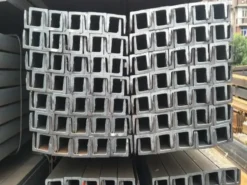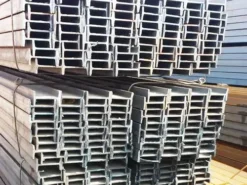I-beam, also known as steel beam (English name Universal Beam), is a long steel bar with an I-shaped cross-section.
-Calssification:
I-beams are mainly divided into ordinary I-beams, light I-beams and wide-flange I-beams.
According to the height ratio of flange to web, it is divided into wide, medium and narrow wide flange I-beams. The first two are produced in sizes 10-60, that is, the corresponding heights are 10 cm-60 cm. At the same height, lightweight I-beams have narrow flanges, thin webs, and light weight. Wide-flange I-beam is also called H-shaped steel. The cross-section feature is that the legs are parallel and there is no slope on the inside of the legs. It is an economical section steel and is rolled on a four-roll universal rolling mill, so it is also called “universal I-beam”.
The specifications are expressed as height × leg thickness × waist thickness. The main dimensions of the specifications can also be expressed by numbers. For example, No. 18 I-beam means an I-beam with a height of 18 cm. If the I-beams are of the same height, the corner code a or b or c can be added after the number to indicate it, such as 36a, 36b, 36c, etc. It is divided into ordinary I-beam, light I-beam and wide-flange I-beam. According to the height ratio of flange to web, it is divided into wide, medium and narrow wide flange I-beams. The first two are produced in sizes 10-60, that is, the corresponding heights are 10 cm-60 cm.
-Application features:
Whether I-shaped steel is ordinary or light, due to the relatively high and narrow cross-sectional dimensions, the moment of inertia of the two main axes of the cross-section is quite different, so it can only be directly used for bending in the plane of its web. components or form them into lattice-type stressed components. It is not suitable to use axial compression members or members that are perpendicular to the web plane and are curved, which greatly limits its application range. I-beams are widely used in buildings or other metal structures.
Ordinary I-beams and light I-beams have relatively high and narrow cross-sectional dimensions, so the moment of inertia of the two main axes of the cross-section is quite different, which limits their application range.
-Hot-rolled I-beam (YB(T)5601987),
(1) Curvature: when the height of the I-beam is less than or equal to 400mm. The curvature per meter shall not be greater than 1.5mm, and the total curvature shall not be greater than 0.15% of the total length. When the height is greater than 400mm, the curvature per meter shall not be greater than 1.0mm, and the total curvature shall not be greater than 0.1% of the total length.
(2) Usually length: model 10-18. Usually length 5-19m: model 20-63, usual length 6-19m, fixed length, double length: When the I-beam is delivered in fixed length or double length, it should be included in the contract Note. The length of fixed length and double length is less than or equal to 8M, and the allowable deviation is +40mm. When the length is greater than 8M, for every additional 1M, the allowable deviation increases by 5MM, but the maximum shall not exceed 80MM.
(3) Weight: I-beams are delivered according to theoretical weight or actual weight: when calculating the theoretical weight, the density of steel is 7.85G/cubic centimeter, and the cross-sectional area calculation formula is: HD+2T(B-D)+0.815(R square-R1 square).











